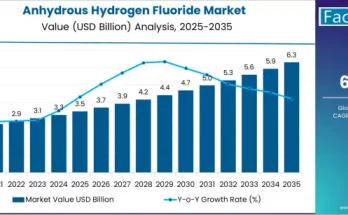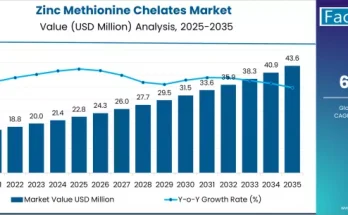Market research indicates that the global zinc sulphate market is poised for robust growth. The market is estimated to be worth around USD 2.0 billion in 2025, and is forecast to expand to approximately USD 3.98 billion by 2035, translating to a compound annual growth rate (CAGR) of about 6.8% over that decade. This growth reflects increasing demand from multiple end-use industries that rely on zinc sulphate as a versatile chemical for both nutritional and industrial applications.
Key Drivers & Market Catalysts
One of the primary growth drivers is the expanding use of zinc sulphate in agriculture as a micronutrient fertilizer. Many soils around the world are zinc deficient, particularly in areas with intensive cropping, and agricultural programs are emphasizing zinc enrichment to improve crop yields, nutritional quality, and soil health. Zinc sulphate’s high solubility makes it a preferred choice in foliar sprays, granular fertilizer blends, and seed coatings.
Another major catalyst comes from the pharmaceutical and nutritional supplement industries. Zinc is an essential trace element for human and animal health; zinc sulphate is widely used to address zinc deficiency in humans and livestock. Demand is rising for high-purity grades used in dietary supplements, medicinal formulations, and feed additives.
Industrial and chemical uses also contribute to growth: zinc sulphate is used in water treatment, textile processing, as a raw material for certain pigments or chemical processes, and as a precursor for synthetic fiber production. These diversified applications provide demand resilience across sectors.
Click Here for Sample Report Before Buying: https://www.factmr.com/connectus/sample?flag=S&rep_id=3663
Product Types & Application Segmentation
Zinc sulphate is available in various hydrate forms including monohydrate, hexahydrate, heptahydrate, and anhydrous. Each form has its own advantages in terms of solubility, handling and suitability for different applications. Heptahydrate is often used in fertigation and precision agriculture because of its good water solubility and ease of dosing. Monohydrate and other hydrates are favored for pharmaceutical and feed applications due to purity and formulation stability.
By application, agriculture leads demand, driven by fertilizer blends and micronutrient supplements. The pharmaceutical/nutritional sector is another major user, especially for human health supplements and feed additives. Other important application areas include water treatment, textile & pigment production, and chemical synthesis.
Regional Insights & Growth Opportunities
Asia-Pacific stands out as a key region, driven by large agricultural sectors, high livestock population, and initiatives to boost crop yields in zinc-deficient soils. Countries with intensive farming and high demand for feed and supplements provide strong growth opportunities.
North America and Europe also represent mature markets with high standards for purity, regulatory compliance, and strong demand from pharmaceuticals and specialty industrial uses. In these regions, zinc sulphate is used in high-quality supplements, water treatment, and industrial chemical processes.
Emerging regions such as Latin America, Africa and parts of the Middle East are becoming increasingly important markets as agricultural modernization increases and demand for nutritional supplements and feed additives grows.
Competitive Landscape & Strategic Trends
The market is competitive with producers of zinc sulphate focusing on improving process efficiency, purity standards, and cost control. Product innovations include dust-free or nano / fine granulated forms for precision dosing, traceability in raw materials, and eco-friendly manufacturing methods.
Suppliers are also forming partnerships with fertilizer companies, pharmaceutical and feed additive manufacturers to ensure supply consistency, meet regulatory requirements and develop specialized grades (e.g. high-purity, low heavy metals).
Challenges & Market Restraints
Some constraints include fluctuations in raw materials (zinc ore or scrap zinc sources), which can affect production cost and pricing. Environmental regulations around mining or chemical processing may impose stricter wastewater controls or emissions limits. Moreover, in price-sensitive agricultural markets, premium grades may be resisted if farmers prefer lower-cost alternatives.
Quality and regulatory compliance are also critical: pharmaceutical or feed-grade zinc sulphate must meet stringent purity limits, which requires investment in high-quality purification and certification.
Forecast & Strategic Recommendations
With the market forecast to grow from USD 2.0 billion in 2025 to USD 3.98 billion by 2035, at a CAGR of ~6.8%, there are significant opportunities for producers, distributors, and end-use manufacturers. Producers should invest in scalable, environmentally compliant manufacturing and develop product grades targeted at agriculture, feed, and pharmaceutical uses.
Agricultural suppliers and fertilizer formulators should consider premium or micronized / fine granulated forms for precision farming, foliar application, and balanced fertilization. Nutritional supplement manufacturers can benefit from high-purity zinc sulphate for human or animal nutrition.
Expanding capacity or establishing regional manufacturing in high-growth agricultural regions (Asia-Pacific, Latin America, Africa) can help meet increasing demand while reducing logistics costs and ensuring local supply.
Browse Full Report: https://www.factmr.com/report/3663/zinc-sulphate-market
Editorial Perspective
Zinc sulphate has become more than just a basic chemical—it is a crucial enabler in agriculture, nutrition, and industrial processes. As the world faces challenges of soil depletion, nutritional deficiencies, and demand for sustainable industrial inputs, zinc sulphate’s role grows ever more critical.
For businesses and investors looking to understand the full potential of this market, a comprehensive market research report provides indispensable data and strategic guidance. It can support business planning, product formulation, investment decisions, and regional expansion strategies based on robust forecasts and market intelligence.


